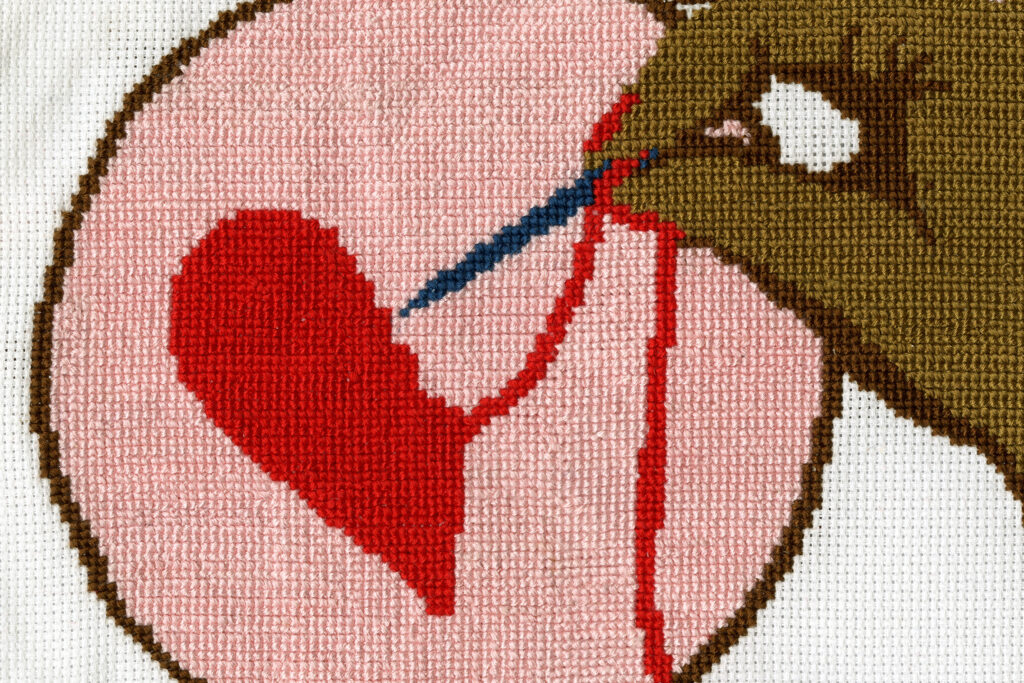While I faced my second divorce at age 39, my best friend came to stay with me, hoping to soften the silence of my suddenly somber house. She brought two things: a box of tissues and a small cross-stitch kit for beginners. I picked up the latter.
It was painfully slow. I spent over 2,000 hours stabbing a piece of cloth with a needle in those fussy X-shapes, waiting for them to reveal a scene of fireflies circling summer lanterns. But it was also hypnotizing. For months, my craft time kept my hands too busy to reach for evening snacks, rage-refresh my phone, or worse, rage-email my ex, and it drowned my mind in concentration. I thought about how the world was wired for speed and spectacle — and how restorative it was to do something that was neither.
In picking up my little hobby, I had inadvertently tapped into a number of forces: a current wave of interest in arts and crafts; a powerful suite of health and mental benefits; and the long, layered history of needlework. I, along with the TikTokers behind the #needlepoint hashtag, are learning what women have known for centuries — sewing is an act of expression, self-care and even rebellion.
Hobbies offer numerous benefits, but crafting comes with special ones. “Detailed hobbies create small zones of predictability, which regulate the nervous system and restore a felt sense of agency,” said Jenny Shields, a psychologist who works with high-performing professionals under sustained stress. She told me my hobby is more than just soothing — it’s psychologically reparative. Craft activities, especially in group settings, can yield increased parasympathetic nervous system activity, a key indicator of relaxation and stress reduction. She added, “For high-achieving professionals, especially those raised to equate stillness with weakness, resilience often shows up through movement. These tactile, meticulous acts aren’t about productivity — they’re about regulation.”
Crafting calms the nervous system and is a powerful form of attention management. Instead of passively cycling through anxious thoughts, you direct your focus toward a task that gives something back. Psychoanalysts call it sublimation — the transmutation of mental energy into something purposeful.
In a 2014 study published in Psychology of Aesthetics, Creativity, and the Arts, researchers examined how certain activities — especially textile handcrafts — can improve mood by inducing a state the researchers call rejuvenation, defined as feeling restored, renewed and ready to begin again. Women identifying as “art makers” (people deeply connected to creative expression) reported significantly higher levels of flow, personal expressiveness, skill and self-realization during crafting. These factors predicted lingering mood improvement, independent of participants’ demographic backgrounds.
Before researchers called it self-care, women knew the needle’s quiet power, as embroidery has served as both a private and public record of protest. In the 1830s, Elizabeth Parker, a young woman in domestic service, stitched prose using red thread embroidered on white linen cloth. Parker used this “sampler” in lieu of a diary to describe her own perceived weaknesses, the abuse she suffered from her employers, as well as her suicidal ideations — a haunting relic. In early 20th-century England, women in the Artists’ Suffrage League embroidered more than 80 protest banners for marches to demand political agency.
Stitching was never just decoration but an enduring global practice, carrying centuries of meaning. In Japan, rural women once practiced sashiko to reinforce and mend work garments; over time, the geometric running stitches evolved into a meditative art form. In Bangladesh and eastern India, kantha work layers worn saris and cloths with simple running stitches, creating vibrant quilts that double as personal narratives; they traditionally passed from mother to daughter. In Turkey, women have long adorned scarves and linens with oya, delicate lace edgings in tiny floral patterns. Each bloom carries its own message.
In conflict-ridden parts of the world, embroidery may carry even deeper significance. The Ukrainian vyshyvanka — an embroidered shirt worn during festivals and, more recently, protests — features motifs of protection, fertility and national pride. The centuries-old tradition of Palestinian tatreez decorates long dresses, each stitch encoding a woman’s village, marital status or social class. After 1948, it became an act of preservation for a displaced people transforming domestic handiwork into a form of cultural resistance, a role it continues to play.
Today, as women fight to impart their influence on the world, needlework still carries a quiet potency. Diana Weymar began stitching quotes and tweets from Donald Trump as a way to process the barrage of language dominating the news cycle. “I was trying to be a humanist in a time when we seemed to be losing our humanity,” she told me. She founded the Tiny Pricks Project on Instagram in 2018. Now, thousands of followers from around the world have sent her their artwork. She saves every physical piece, adding, “Unlike something I stitch, my digital account could be deleted at any time.”
Although Weymar never set out to amass a political art archive, she now has a growing collection of more than 5,000 hand-embroidered pieces from global contributors that she features on her page. “What if we stopped thinking about stitching and crafts historically connected to ‘women’s work’ as subversive and thought of how we live now, phones practically attached to our hands, as subverting our humanity?” she says.
In embroidery, the artist pulls the strands apart, separates them and smooths them straight to avoid getting tangled — a beautiful metaphor for emotional clarity and generational healing. In this, I’m reminded that thousands of small acts mark and make a life. As the brightly colored floss falls into order, so does my equilibrium. What begins as a small gesture of order unfurls inward, giving my mind and body a ritual for repair.
The post This hobby can soothe the brain, heal the psyche and keep you from texting your ex
appeared first on Washington Post.




